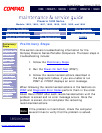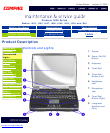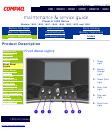
United States January 3, 2003
Presario 1600 Series
Models: 1683, 1685, 1687, 1688, 1690, 1692, 1693, and 1694
Before You Begin Specifications Parts Catalog
Removal Sequence Troubleshooting Battery Operations
Product Description Pin Assignments
Index
Preliminary
Steps
Clearing the
Power-On
Password
Power-On
Self Test
(POST)
Compaq
Diagnostics
Diagnostic
Error Codes
Solving
Minor
Problems
Contacting
Compaq
Support
Running POST
To run POST, complete the following steps:
● Turn off the computer, then turn on the computer.
● If POST does not detect any errors, the computer will not beep. This
indicates successful completion of POST test. POST has run successfully
and boots from the hard drive (or from a bootable diskette if one is
installed in the diskette drive).
● If POST detects errors, the errors are indicated by screen and/or audible
messages. Refer to "Power-On Self-Test (POST) Codes" in the tables for
a list of POST codes and their relevant descriptions.
NOTE:
If the system is not functioning well enough to run POST, or if the
display is not functioning well enough to show POST error messages,
refer to the Troubleshooting tables.
NOTE:
The following routines are sorted by their test point
numbers assigned in the BIOS code. Their actual orders
as executed during POST can be quite different.
Code Beeps POST Routine Description
02h Verify Real Mode
03h Disable Non-Maskable Interrupt (NM)
04h Get CPU type
06h Initialize system hardware
08h Initialize chipset with Initial POST values
09h Set IN POST flag
0Ah Initialize CPU registers
0Bh Enable CPU cache
0Ch Initialize caches to initial POST values
0Eh Initialize I/O component
0Fh Initialize the local bus IDE
10h Initialize Power Management
11h
Load alternate registers with initial POST
values
12h
Restore CPU control word during warm
boost
13h Initialize PCI Bus Mastering devices
14h Initialize keyboard controller
16h
1-2-2-3
BIOS ROM Checksum
17h Initialize cache before memory autosize
18h 8254 timer initialization
1Ah 8237 DMA controller initialization
1Ch Reset Programmable Interrupt Controller
20h
1-3-1-1
Test DRAM refresh
22h
1-3-1-3
Test 8742 Keyboard Controller
24h Set ES segment register to 4 GB
26h Enable A20 line
28h Autosize DRAM
29h Initialize POST Memory Manager
2Ah Clear 512 KB base RAM
2Ch 1-3-4-2
RAM failure on address line xxxx*
2Eh 1-3-4-3
RAM failure on data bits xxxx* of low byte
of memory bus
2Fh
Enable cache before system BIOS shadow
30th 1-4-1-1
RAM failure on data bits xxxx*of high byte
memory bus
32h
Test CPU bus-clock frequency
33h
Initialize Phoenix Dispatch Manager
36h
Warm start shut down
38h
Shadow system BIOS ROM
3Ah
Autosize cache
3Ch
Advanced configuration of chipset registers
3Dh
Load alternate registers with CMOS values
42h
Initialize interrupt vectors
45h
POST device initialization
46h 2-1-2-3
Check ROM copyright notice
48h
Check Video configuration against CMOS
49h
Initialize PCI bus and devices
4Ah
Initialize all video adapters in system
4Bh
QuietBoot start (optional)
4Ch
Shadow video BIOS ROM
4Eh
Display BIOS copyright notice
50Eh
Display CPU type and speed
51h
Initialize EISA board
52h
Test keyboard
54h
Set key click if enabled
58h 2-2-3-1
Test for unexpected interrupts
59h
Initialize POST display service
5Ah
Display prompt "Press F2 to enter SetUP"
5Bh
Disable CPU cache
5Ch
Test RAM between 512 and 640 KB
60h
Test extended memory
62h
Test extended memory address lines
64h
Jump to UserPatchI
66h
Configure advanced cache registers
67h
Initialize Multi Processor APIC
68h
Enable external and CPU cache
69h
Setup System Management Mode (SMM)
area
6Ah
Display external L2 cache size
6Bh
Load custom defaults (optional)
6Ch
Display shadow-area message
6Eh
Display possible high address for UMB
recovery
70h
Display error messages
72h
Check for configuration errors
76h
Check for keyboard errors
7Ch
Set up hardware interrupt vectors
7Eh
Initialize coprocessor if present
80h
Disable onboard Super I/O ports and IRQs
81h
Late POST device initialization
82h
Detect and install external RS232 ports
83h
Configure non-MCD IDE controllers
84h
Detect and install external parallel ports
85h
Initialize PC-compatible PnP ISA devices
86h
Reinitialize onboard I/O ports
87h
Configure Motherboard Configurable
Devices (optional)
88h
Initialize BIOS Data Area
89h
Enable Non-Maskable Interrupts (NMIs)
8Ah
Initialize Extended BIOS Data Area
8Bh
Test and initialize PS/2 mouse
8Ch
Initialize floppy controller
81h
Determine number of ATA drives (optional)
90h
Initialize hard disk controllers
91h
Initialize local-bus hard disk controllers
92h
Jump to UserPatch2
93h
Build MPTABLE for multi-processor boards
95h
Install CD ROM for boot
96h
Clear huge ES segment register
97h
Fixup Multi Processor table
98h 1-2
Search for option ROMs. One long, two
short beeps on checksum failure
99h
Check for SMART drive (optional)
9Ah
Shadow option ROMs
9Ch
Set up Power Management
9Dh
Initialize security engine (optional)
9Eh
Enable hardware interrupts
9Fh
Determine number of ATA and SCSI drives
A0h
Set time of day
A2h
Check key lock
A4h
Initialize Typematic rate
A8h
Erase F2 prompt
AAh
Scan for F2 key stroke
ACh
Enter Setup
AEh
Clear Boot flag
B0h
Check for errors
B2h
POST done - prepare to boot operating
system
B4h
1 One shot beep before boot
B5h
Terminate QuietBoot (optional)
B6h
Check password (optional)
B9h
Prepare Boot
BAh
Initialize DMI Parameters
BBh
Initialize PnP Option ROMs
BCh
Clear parity checkers
BDh
Display MultiBoot menu
BEh
Clear screen (optional)
BFh
check virus and back up reminders
C0h
Try to boot with INT 19
C1h
Initialize POST Error Manager (PEM)
C2h
Initialize error logging
C3h
Initialize error display function
C4h
Initialize system error handler
C5h
PnPnd dual CMOS (optional)
C6h
Initialize notebook docking (optional)
C7h
Initialize notebook docking late
C8h
Force check (optional)
C9h
Extended checksum (optional)
D2h
Unknown interrupts
Code Beeps For Boost Block in Flash ROM
E0h Initialize the chipset
E1h Initialize the bridge
E2h Initialize the CPU
E3h Initialize system timer
E4h Initialize system I/O
E5h Check force recovery boot
E6h Checksum BIOS ROM
E7h Go to BIOS
E8h Set Huge Segment
E9h Initialize Multi Processor
EAh Initialize OEM Special code
EBh Initialize PIC and DMA
ECh Initialize Memory type
EDh Initialize Memory size
EEh Shadow Boot Block
EFh System memory test
F0h Initialize interrupts vectors
F1h Initialize Run Time Clock
F2h Initialize Video
F3h Initialize beeper
F4h Initialize boot
F5h Clear Huge segment
F6h Boot to Mini DOS
F7h Boot to Full DOS
privacy and legal statement


















